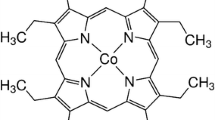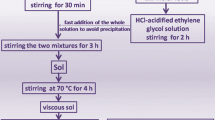Abstract
Coumarin 1, Coumarin 2 and Coumarin 120 are embedded in transparent sol-gel glass samples prepared by sol-gel process using dip method. The sol-gel matrix is given dip treatment with Methanol /Distilled Water (50/50vol) for 1 to 16h before dipping into dye solution. The effect of dipping time of matrix in Methanol/ Distilled Water on spectroscopic properties of coumarin dye doped glass samples has been studied. The Optical Density (OD) at absorption maximum wavelength and Fluorescence Intensity (FI) at fluorescence maximum wavelength of all coumarin dyes increase with the time of dipping of the sol-gel sample. These absorption/fluorescence properties of coumarin dyes in sol-gel glass matrices are compared with its respective properties in methanolic solution in acidic environment. The cause of these changes in OD/FI with dipping time is discussed by taking into account the absorption / fluorescence of dye in acidified methanol.





Similar content being viewed by others
References
Schafer FP (1989) Topics in applied physics vol 1, in: Dye lasers. Springer, New York
Avnir D, Levy D, Reisfeld R (1984) The nature of silica cage as reflected by spectral changes and enhanced photostability of trapped rhodamine 6G. J. Phys. Chem. 88:5956–5959 doi:10.1021/j150668a042
Avnir D, Kaufman VR, Reisfeld R (1985) Organic fluorescent dyes trapped in silica and silica-titania thin films by the sol-gel method. Photophysical, film and cage properties. Jn. Non-Cryst. Solids. 74:395–406
Deshpande AV, Panhalkar RR (2002) Spectroscopic properties of coumarin 2 in HCl and HNO3 catalysed sol-gel glasses. J. Lumin. 96:185–193 doi:10.1016/S0022-2313(01)00218-6
Deshpande AV, Kumar U (2002) Effect of method of preparation on photophysical properties of Rh-B impregnated sol-gel hosts. Jn. Non-Cryst. Solids. 306:149–159
Sastre R, Costela A (1995) Polymeric solid-state dye lasers. Adv. Mater. 7:198–202 doi:10.1002/adma.19950070222
Rahn MD, King TA (1995) Comparison of laser performance of dye molecules in sol-gel, polycom, ormosil, and poly (methyal methacrylate) host media. Appl. Opt. 34:8260–8271
Popov S (1998) Dye photodestruction in a solid-state dye laser with a polymeric gain medium. Appl. Opt. 37(27):6449–6455 doi:10.1364/AO.37.006449
Bakr NA, Mansour AF, Hammam M (1999) Optical and thermal spectroscopic studies of luminescent dye doped poly(methyl methacrylate) as solar concentrator. J. Appl. Polym. Sci. 74(14):3316–3323 doi:10.1002/(SICI)1097-4628(19991227)74:14<3316::AID-APP4>3.0.CO;2-U
Huang J, Bekiari V, Lianos P (1999) Study of poly(methyl methacrylate) thin films doped with laser dyes. J. Lumin. 81(4):285–291 doi:10.1016/S0022-2313(99)00010-1
Deshpande AV, Namdas EB (1996) Efficient lasing action of rhodamine 6G in Nafion membranes. Chem. Phys. Lett. 263:449–455 doi:10.1016/S0009-2614(96)01247-X
Deshpande AV, Namdas EB (1997) Lasing action of rhodamine B in polyacrylic acid films. Appl. Phys. B 64:419–422 doi:10.1007/s003400050193
Deshpande AV, Kumar U (2006) Molecular forms of coumarin-307 in sol-gel glasses. J. Fluoresc. 16:679–687 doi:10.1007/s10895-006-0109-5
Lo D, Lam SK (1998) Lasing behaviour of sol-gel silica doped with uv laser dyes. Appl. Phys. B 66:427–430 doi:10.1007/s003400050413
Li D, Zhao W, Sun X, Zhang J, Anpo M, Zhao J (2006) Photophysical properties of coumarin derivatives incorporated in MCM-41. Dyes Pigments 68:33–37 doi:10.1016/j.dyepig.2004.12.015
Suratwala T, Garadlund Z, Davidson K, Uhlmann DR (1998) Silyated coumarin dyes in sol-gel hosts. 2. photostability and sol-gel processing. Chem. Mater. 10:199–209 doi:10.1021/cm970340s
Koppylova TN, Mayer GV, Renzichenko AV, Samsonova LG, Sevetlichnyi VA, Dolotov MS, Tavrizova MT (2004) Active media for tunable blue-green lasers based on aminocoumarins in polymethylmethacrylate. Appl. Phys. B 78:183–187 doi:10.1007/s00340-003-1352-y
Whang CM, Oh EO, Gupta RK (2003) Effect of pH and dye concentration on the optical and structural properties of coumarin-4 dye-doped SiO2-PDMS xerogels. Jn. Sol-Gel Sci. Techno. 28:279–288
Qian G, Yang Y, Su D, Wang Z, Wang M (2005) Luminiscence and laser performance of coumarin dyes doped in ORMOSILs. Mater. Sci. Eng. B 119:192–195 doi:10.1016/j.mseb.2005.02.059
Unger B, Rurack K, Muller R, Jancke H, Genger U (2005) Microscopic vs. macroscopic structural evolution of SiO2 sols and gels employing a tailor-made fluorescent reporter dye. J. Mater. Chem. 15:3069–3083 doi:10.1039/b501622c
Lo D, Parris JE, Lawless JL (1993) Laser and fluorescence properties of dye-doped sol-gel silica from 400 nm to 800 nm. Appl. Phys. B 56:385–390 doi:10.1007/BF00324537
Kim G, Lee D, Kim J, Moon J, Lee H (1997) Effect of microstructural change on the optical property of ormosil embedded with organic molecules. Jn. Sol-Gel Sci. Techno. 10:283–289
Choi D, Lim C, Sohn S (2003) Optical properies of coumarin 314 doped sol-gel silica rods, Optik – International. Jn. for Light and Electron Optics 114:347–350
Hou L, Hoffmann B, Schmidt H, Menning M (1997) Effect of heat treatment and additivies on the Photochromic and mechanical properties of sol-gel derived photochromic coatings containing spirooxazine. Jn. Sol-Gel Sci. Techno. 8:923–926
Grandi S, Tomasi C, Mustarelli P, Clemente F, Carbonaro CM (2007) Characterisation of a new sol-gel precursor for a SiO2-rhodamine 6G hybrid class II material. Jn. Sol-Gel Sci. Techno. 41:57–63
Campillo AJ, Clark JH, Shapiro SL, Winn KR, Woodbridge PK (1979) Excited-state protonation kinetics of coumarin 102. Chem. Phys. Lett. 67(2–3):218–222 doi:10.1016/0009-2614(79)85150-7
Kunjappu JT (1993) Photophysical properties of five laser dyes (C120, C1, C102, C1F and C153) in homogeneous, surfactant and membrane media, Jn. Photochem. Photobiol. Chem. (Kyoto) 71(3):269–273
Jones G II, Rahman MA (1994) Fluorescence properties of coumarin laser dyes in aqueous polymer media. Chromophore isolation in poly(methacrylic acid) hypercoils. J. Phys. Chem. 98:13028–13037 doi:10.1021/j100100a035
Samanta A, Fessenden RW (2000) Excited-state dipole moment of 7-aminocoumarins as determined from time-resolved microwave dielectric absorption measurements. J. Phys. Chem. A 104(37):8577–8582 doi:10.1021/jp001676j
Fisher A, Cremer C, Sterlzer EHK (1995) Fluorescence of coumarins and xanthenes after two-photon absorption with a pulsed titanium—sapphire laser. Appl. Opt. 34(12):1989–2003
Haidekker MA, Brady TP, Lichlyter D, Theodorakis EA (2005) Effect of solvent polarity and solvent viscosity on the fluorescent properties of molecular rotors and related probes. Bioorg. Chem. 33:415–425 doi:10.1016/j.bioorg.2005.07.005
Arbeloa TL, Arbeloa FL, Tapia MJ, Arbelo IL (1993) Hydrogen-bonding effect on the photophysical properies of 7-aminocoumarin derivatives. J. Phys. Chem. 97:4704–4707 doi:10.1021/j100120a024
Drexhage KH (1989) In F. P. Schafer (Ed.), Dye Lasers, Springer, New York, pp. 172–175
Costela A, Moreno I, Figuera J, Guerri F, Sastre R (1998) Polymeric matrices for lasing dyes: recent development. Laser Chem. 18:63–84 doi:10.1155/1998/71976
Jones G II, Jackson WR, Choi C, Bergmark WR (1985) Solvent effects on emission yield and lifetime for coumarin laser dyes. Requirments for a rotatory decay mechanism. J. Phys. Chem. 89:294–300 doi:10.1021/j100248a024
Trozzolo AM, Dienes A, Shank CV (1974) Excited-state reactions of laser dye. Evidence for a two- step phototautomerism in 7-hydroxy-4 methyl coumarin. J. Am. Chem. Soc. 96(14):4699–4700 doi:10.1021/ja00821a070
Moriya T (1983) Excited-state reactions of coumarins in aqueous solutions. I. The photoautomerization of 7-hydroxycoumarin and its derivative. Bull. Chem. Soc. Jpn. 56:6–14 doi:10.1246/bcsj.56.6
Author information
Authors and Affiliations
Corresponding author
Rights and permissions
About this article
Cite this article
Deshpande, A.V., Jathar, L.V. & Rane, J.R. Effect of Matrix Treatment on Spectroscopic Properties of HCl Catalysed Sol-Gel Glasses Containing Coumarin Laser Dyes. J Fluoresc 19, 607–614 (2009). https://doi.org/10.1007/s10895-008-0451-x
Received:
Accepted:
Published:
Issue Date:
DOI: https://doi.org/10.1007/s10895-008-0451-x




